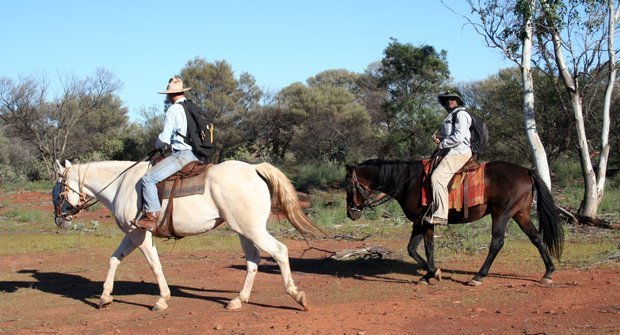Horses invaluable for tracking bilbies

ONE OF AUSTRALIA’S MOST endangered and endeared species is a tough little marsupial to find. Populations of the elusive bilby (Macrotis lagotis) are scattered in burrows over vast swathes of land in Western Australia, making them a hard target to study.
But now researchers are turning to an age-old method: horseback mustering.
Zoologist Dr Neil Burrows, lead researcher at WA’s Department of Environment and Conservation says the decision to use horses to track reintroduced bilbies made a lot of sense.
“In the past, we’ve tried using quad bikes and all-terrain vehicles, but they have a large impact on the environment. We tried using observers on foot, but people can’t cover much distance before becoming fatigued.”
Bilbies, which have bandicoot-like features and are the size of a rabbit, are nocturnal and naturally secretive, so researchers instead go in search of signs of the animals’ presence.
“It’s really important for our work and our peace of mind. We need to know whether these animals we’re releasing are surviving – whether their populations are increasing or decreasing,” says Neil. “Using horses is ideal. They cover ground over all kinds of terrain, and being so high up gives you such a large field of view when looking for tracks and signs. We’ve been calling it ‘the Great Bilby Muster’…We have also been recording signs of any animals in the area.”

Bilbies were provided with artificial burrows when first released. Lorna Glen bilbies are now digging their own burrows. (Credit WA DEC)
Conservation success in Lorna Glen
Lorna Glen – a 2450sq.km property 1200km east of Perth – was once a pastoral lease but has since been acquired by the WA government for development of cultural and conservation projects, in partnership with the Wiluna people, traditional owners of the area. It is largely funded by the local mining industry.
Neil says that part of Lorna Glen’s success is the holistic approach that has been taken in its rehabilitation. “We first removed residual domestic stock and closed down artificial water points, like dams. We controlled feral camels and donkeys and we have an annual program for the baiting of cats, foxes and dogs.”
Aside from the bilby, the group aims to reintroduce 10 other native mammal species to the reserve.
Aboriginal locals share tracking expertise
Aboriginal locals’ expertise in horsemanship will also be used to help track bilbies, says Neil.
“Many traditional owners have a profound understanding and working knowledge of animal tracks, and many come from ex-pastoral lease employment and are therefore excellent horsemen,” he says. “We will be looking to approach the traditional owners to help us expand these types of surveys over a much larger area.”
Frank Manthey, co-founder and spokesperson for the Save the Bilby Fund hails the study as a work of inspiration. “I think it’s just a magic idea,” he says. “People with any experience in these things would know how easy it is to track from horseback – and it’s something that can be taught.”
For conservation workers like Frank, any step forward in the reintroduction of species like the bilby is all-important.
“The bilby has become a flagship for a whole bunch of species,” Frank says. “We would really deserve a kick in the backside if we were to ever lose these beautiful animals.”
RELATED STORIES

